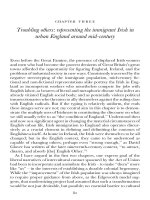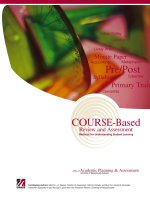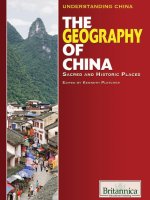Urban+Geography+Syllabus.Fall2003
Bạn đang xem bản rút gọn của tài liệu. Xem và tải ngay bản đầy đủ của tài liệu tại đây (65.14 KB, 6 trang )
GEOG 28: Urban Social Geography
Tuesdays & Thursdays 11:00am-12:15pm
Davie Hall 112
Fall 2003
University of North Carolina-Chapel Hill
Dr. James Fraser
Assistant: Nancy Xenelis
Office: Hickerson House, Rm. 205
Phone: 962-6835
Office Hours: TBA
Office Hours: 12:30-2 T, TH at Strong’s Coffee
(on Franklin next to Sutton’s Apothecary)
Course overview
This class will introduce students to the ways in which urban geography has played a role, along
with other disciplines that focus on the urban, in understanding cities and the issues that surround
them. This will include an examination of how cities are conceived, lived, represented. That is,
this class will ask the questions, what are the various ways that people create, and attempt to
materialize, their geographical imaginations of what they want the city to be? What are the ways
in which different social groups make claims on space and place, and how does the scale at which
these activities occur have effects. In addressing these questions we will be analyzing how the
state, market, and civil society intersect, and how this has changed over the 20 th Century in the
U.S. and other parts of the world. In responding to these issues we will consider how boundaries
get drawn in cities, where those boundaries exist and what the consequences are for such
boundaries.
Course format and expectations
The format of the class follows below. It is expected that people will come to class prepared to
discuss the material. This will be reflected in a substantial portion of time being used for activitybased learning in the classroom. Typically, we will meet and have about a 20-30 focused
lecture/discussion on the readings, a 30 minute session where students will work in small groups
reporting back to the larger class, and 15 minutes of wrap-up. We will be viewing six films that
accompany the texts we are using for the class, and students will be expected to incorporate these
audio-visual materials into their responses to examination questions. As for the mechanisms used
to grade student performance, we will have three (3) examinations which will contain five short
essay items each. In addition, there will be a 7-10 page paper due toward the end of the semester.
Students are expected to adhere to the University honor code, which can be viewed at
There is no final exam.
Grading
Grading will follow the standard grading system of the university (A, B, C, D, F). Each
examination will be worth 25% of your final grade and the term paper will also represent 25%.
For a general indication of how grades are to be assigned, “A” course work demonstrates an
excellent understanding of course material and themes, significant contributions in class
discussions, completion of examinations and the term paper with a high level of critical thinking
and well written responses. “B” course work demonstrates a strong understanding of course
material and themes, consistent contributions in class discussions, completion of examinations
and term paper with some critical thinking skill and well written responses. “C” course work
demonstrates a general understanding of course material and themes, minimal contributions in
class discussions, completion of examinations, and a term paper that summarize ideas examined
in the course. “D” course work demonstrates a vague understanding of course material and
1
themes, occasional or no contributions in class discussions, incompletion of examination, and a
poorly written term paper. “F” course work demonstrates that a student was rarely present for
class, rarely demonstrated completion of readings, examinations, and handed in a substandard
term paper.
Readings & Course Materials
There are two books that students must purchase for the class:
-Steve Pile, et al., Unruly cities
-John Allen, et al., Unsettling Cities
Both books are available at Student Stores. All other readings will be on reserve at the
Undergraduate Library unless the url is given in the syllabus. It is recommended that students
refer to The Dictionary of Human Geography 4th Edition (edited by R.J. Johnston, et al)
throughout the semester for definitions, summaries and clarification for terms and concepts used
during the course.
The Syllabus
Week 1 Thinking about cities relationally
T Aug. 26—Introduction to course, course expectations & requirements
Informal small group discussion: Why urban geography?
READ for next class: -Chapter 1, Unsettling Cities, Cities of Connection and
Disconnection
R Aug. 28—Thinking about the Scale of Cities
Lecture & Discussion: What does it mean to think about a city relationally? What are
some of the ambivalent tensions about cities that you have noted in your everyday life?
READ for next class: -Chapter 2, Unsettling cities, Moving Cities: transport
connections
ASMNT for next class: Choose a city that you would like to focus on for the ongoing
class activities and term paper. What were some of the reasons you decided on the city?
Bring in some basic demographics and information that you can share in class about the
city you chose. This should only require web-based research.
Week 2 Networks of connections
T Sept. 2—Continuing to Explore the Making of Connections
Lecture: How are cities multi-scalar constructions?
Class Film: “New York: Making Connections”
R Sept. 4—Transport: Access to the City and Beyond
Class Activity: Exploring current course themes through term papers
Class Discussion: What’s mobility got to with freedom and rights to the city?
READ for next class: -Chapter 1, Unruly Cities, The Heterogeneity of Cites
2
Week 3 Negotiating diversity in the city
T Sept. 9—Negotiating Differences in the City
Lecture & Discussion: U.S. Federal Policies and spatial disconnection – A history of
the production of suburbs and ‘ghettos’.
ASMT for next class: Find some historical records that show how spaces in your city
have become altered by social relations extending beyond the city (i.e., federal or state
policy, migration patterns, movement of industry). Then, focus on at least one area of
your city and discuss in more detail how it has transformed over time.
READ for next class: Chapter 2, Unruly Cities, Urban ‘disorders’
R Sept. 11—Defining and Responding to Urban (dis)Order
Class Lecture/Discussion: The discourses around urban poverty and (dis)order
Class Film: Mexico City: Whose City
READ for next class: -Chapter 3, Unsettling Cities, City Life and difference:
negotiating diversity
Week 4 Diversity and spatial differentiation in the city
T Sept. 16—Movement and Settlement in the City
Lecture & Discussion: How are identities and space connected?
Class Film: Sydney: Living with Difference
Discussion: What makes Sydney’s distinctive cultural life possible?
R Sept. —18 Meet with partners in class to map out the work you have done and need to do in
order to connect your city term paper projects to course themes we have covered.
READ for next class: -Chapter 3, Unruly Cities, Walled Cities: surveillance,
regulation, and segregation
Week 5 Spatial patterns and segregation
T Sept. 23—What ways do different groups separate and distance themselves form each other?
How are these social relations constituted, in part, by the built environment?
Lecture and Discussion: Re-Claiming the city: Gentrification and the ‘Back to the city
movement’
R Sept. 25—Examination 1 & Discussion
ASMT for next class: Locate information for your city on the ways in which immigrants
(newcomers to the city) have spatially located. Are there detectable patterns, an, if so,
delve deeper into the factors that account for these. More broadly, begin to identify the
general spatial patterning of your city paying attention to issues the ways that different
populations have made claims to public and private space. Do any areas have a
reputation for certain types of activities or populations residing in them? How has this
come to be?
READ for next class: -Chapter 4, Unruly Cities, Divisive Cities: power and
segregation in cities
Week 6 Spatial pattern, the city, and urban sprawl
T Sept. 30—Observing Spatial Patterns
Lecture & Discussion: Segregation in Charlotte, NC, from the 19 th Century
3
R Oct. 2—Cities and Social Environmental Issues
Class Film: Subdivide and Conquer
READ for next class: -Chapter 4, Unsettling Cities, Cities and natures: intimate
strangers
ASMT for next class: Go to the Baltimore Ecosystem Study home web page and view
the ways in which urban environmental issues are constructed. Come to class prepared to
provide an overview of the main components of the overall project, and to discuss the
ways that the BES web site constructs the issues to be addressed.
Week 7 Sustainable cities and urban governance
T Oct. 7—How are cities becoming sustainable?
GIS Training: Amanda Henley Presentation
Lecture & Discussion: The Baltimore Ecosystem Study
READ for next class: -Chapter 6, Unruly Cities, The unsustainable city?
ASMT for next class: Look up information on your city to find examples of initiatives
that deal with urban sustainability, broadly speaking (i.e., social and environmental).
How are these efforts conceived, who is responsible for their progress, and what
challenges do you see that they face?
R Oct. 9—City politics and the environment
Lecture & Discussion: Environmental politics and issues of urban development – the
case of urban gardens
Class Activity –discuss spatial patterns in your cities
Class Activity: What initiatives have your city taken to be socially and
environmentally sustainable? How are these interrelated processes?
Week 8 The scale of urban governance
T Oct. 14——City politics and governance in the 20th and 21st Centuries
Lecture & Discussion: Theories of urban politics – What’s power got to do with it?
READ for next class: -Chapter 5, Unruly Cities, City Politics
ASMT for next class: Look up information on the type of governance structure(s) that
are in place in your city. These would include institutionalized channels through which
decisions get made. In addition, focus on issues of land use. What stakeholders are
involved in conceiving and representing the city? For example, you might find a
planning agency and determine what roles it plays, or you may focus on private actors
including foundations or corporations.
R Oct. 16—Who governs and where do they operate?
Who is a stakeholder in urban governance? What does scale got to do with it?
Lecture & Discussion: Examining the scale of urban governance
Class Activity –discuss the stakeholders who are involved in urban politics. Do these
groups reside in the city or outside of the city?
READ for next class: -Chapter 7, Unruly Cities, Administered Cities
Week 9 Administered Cities: Managing Unruly Places
T Oct 21—How does the city become administered? What groups have been involved in these
processes?
Lecture & Discussion: Examining the administration of social services through
4
nonprofits
READ for next class: -Chapter 5, Unsettling Cities, Cities of power and influence:
settled formations
R Oct. 23—Fall Break
Week 10 Cities of all sizes
T Oct. 28—How do cities intersect with economic, political, and cultural globalization?
Class Film: Cities in a Hurry
R Oct. 30—Examination 2 & Discussion
Week 11 Urban revitalization around the world
T Nov. 4—Does size matter? Mid-size cities and global ambition
Lecture & Discussion: what strategies are different cities using to be networked in
flows of capital, people, knowledge, and culture?
READ for next class: -Chapter 6, Unsettling Cities, City rythms: neo-liberalism and
the developing world
R Nov. 6— How do different cities around the world experience development? What are some
of the ways in which cities in less affluent countries experience monetary policy set by
organizations operating globally?
Lecture & Discussion: Transnational urban experiences: flows that tie and flows that
Bind
Class Activity – Think about how you would study this in your cities. What have you
learned so far, and what avenues will you pursue?
READ for next class: -Chapter 7, Unsettling Cities, Cities and economic
change: global governance
Week 12 Neoliberalism and it limits
T Nov. 11
Lecture & Discussion: Neoliberalism and the City: There is an alternative
ASMT for next class: What actually existing policies and programs are affecting, and
have affected, the cities you are studying? How have these cities actually played a role in
constituting such programs and policies and perhaps altering them?
R Nov. 13— What are the components of neoliberalist discourse and activities, and how
pervasive is this political-economic strategy?
Class Discussion: We will break into small groups and then return to a larger
discussion toward the middle of class. Talk about your cities and the ways they are being
neo-liberalized or not.
READ for next class: -Both Chapters 8 in Unsettling cities and Unruly cities
Week 13 Visions of the city
T Nov. 18—The jumbled orderings of the city
Lecture & Discussion: Social movements in the city: part 1
R Nov. 20—How open are cities?
Lecture & Discussion: Geographical imaginaries for the city: social movements part 2
5
Week 14
T Nov. 25—No class; work on term papers
R Nov. 27—No Class; Thanksgiving Break
Week 15 Finding our way home
T Dec. 2— Term Papers Due & Review Session for Third Examination
R Dec. 4—3rd Examination & Class Wrap-Up
6









